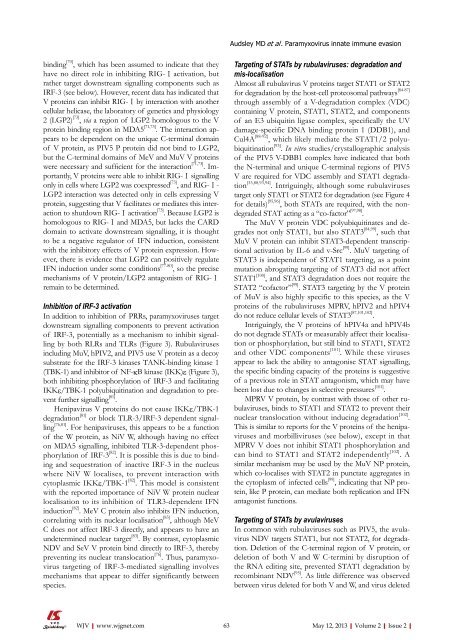Paramyxovirus evasion of innate immunity: Diverse strategies for ...
Paramyxovirus evasion of innate immunity: Diverse strategies for ...
Paramyxovirus evasion of innate immunity: Diverse strategies for ...
You also want an ePaper? Increase the reach of your titles
YUMPU automatically turns print PDFs into web optimized ePapers that Google loves.
Audsley MD et al . <strong>Paramyxovirus</strong> <strong>innate</strong> immune <strong>evasion</strong>binding [70] , which has been assumed to indicate that theyhave no direct role in inhibiting RIG-Ⅰ activation, butrather target downstream signalling components such asIRF-3 (see below). However, recent data has indicated thatV proteins can inhibit RIG-Ⅰ by interaction with anothercellular helicase, the laboratory <strong>of</strong> genetics and physiology2 (LGP2) [73] , via a region <strong>of</strong> LGP2 homologous to the Vprotein binding region in MDA5 [71,73] . The interaction appearsto be dependent on the unique C-terminal domain<strong>of</strong> V protein, as PIV5 P protein did not bind to LGP2,but the C-terminal domains <strong>of</strong> MeV and MuV V proteinswere necessary and sufficient <strong>for</strong> the interaction [71,73] . Importantly,V proteins were able to inhibit RIG-Ⅰ signallingonly in cells where LGP2 was coexpressed [73] , and RIG-Ⅰ-LGP2 interaction was detected only in cells expressing Vprotein, suggesting that V facilitates or mediates this interactionto shutdown RIG-Ⅰ activation [73] . Because LGP2 ishomologous to RIG-Ⅰ and MDA5, but lacks the CARDdomain to activate downstream signalling, it is thoughtto be a negative regulator <strong>of</strong> IFN induction, consistentwith the inhibitory effects <strong>of</strong> V protein expression. However,there is evidence that LGP2 can positively regulateIFN induction under some conditions [77-80] , so the precisemechanisms <strong>of</strong> V protein/LGP2 antagonism <strong>of</strong> RIG-Ⅰremain to be determined.Inhibition <strong>of</strong> IRF-3 activationIn addition to inhibition <strong>of</strong> PRRs, paramyxoviruses targetdownstream signalling components to prevent activation<strong>of</strong> IRF-3, potentially as a mechanism to inhibit signallingby both RLRs and TLRs (Figure 3). Rubulavirusesincluding MuV, hPIV2, and PIV5 use V protein as a decoysubstrate <strong>for</strong> the IRF-3 kinases TANK-binding kinase 1(TBK-1) and inhibitor <strong>of</strong> NF-κB kinase (IKK)ε (Figure 3),both inhibiting phosphorylation <strong>of</strong> IRF-3 and facilitatingIKKε/TBK-1 polyubiquitination and degradation to preventfurther signalling [81] .Henipavirus V proteins do not cause IKKε/TBK-1degradation [81] or block TLR-3/IRF-3 dependent signalling[76,81] . For henipaviruses, this appears to be a function<strong>of</strong> the W protein, as NiV W, although having no effecton MDA5 signalling, inhibited TLR-3-dependent phosphorylation<strong>of</strong> IRF-3 [82] . It is possible this is due to bindingand sequestration <strong>of</strong> inactive IRF-3 in the nucleuswhere NiV W localises, to prevent interaction withcytoplasmic IKKε/TBK-1 [82] . This model is consistentwith the reported importance <strong>of</strong> NiV W protein nuclearlocalisation to its inhibition <strong>of</strong> TLR3-dependent IFNinduction [82] . MeV C protein also inhibits IFN induction,correlating with its nuclear localisation [83] , although MeVC does not affect IRF-3 directly, and appears to have anundetermined nuclear target [83] . By contrast, cytoplasmicNDV and SeV V protein bind directly to IRF-3, therebypreventing its nuclear translocation [76] . Thus, paramyxovirustargeting <strong>of</strong> IRF-3-mediated signalling involvesmechanisms that appear to differ significantly betweenspecies.Targeting <strong>of</strong> STATs by rubulaviruses: degradation andmis-localisationAlmost all rubulavirus V proteins target STAT1 or STAT2<strong>for</strong> degradation by the host-cell proteosomal pathways [84-87]through assembly <strong>of</strong> a V-degradation complex (VDC)containing V protein, STAT1, STAT2, and components<strong>of</strong> an E3 ubiquitin ligase complex, specifically the UVdamage-specific DNA binding protein 1 (DDB1), andCul4A [88-92] , which likely mediate the STAT1/2 polyubiquitination[93] . In vitro studies/crystallographic analysis<strong>of</strong> the PIV5 V-DBB1 complex have indicated that boththe N-terminal and unique C-terminal regions <strong>of</strong> PIV5V are required <strong>for</strong> VDC assembly and STAT1 degradation[33,88,93,94] . Intriguingly, although some rubulavirusestarget only STAT1 or STAT2 <strong>for</strong> degradation (see Figure 4<strong>for</strong> details) [95,96] , both STATs are required, with the nondegradedSTAT acting as a “co-factor” [97,98] .The MuV V protein VDC polyubiquitinates and degradesnot only STAT1, but also STAT3 [84,99] , such thatMuV V protein can inhibit STAT3-dependent transcriptionalactivation by IL-6 and v-Src [99] . MuV targeting <strong>of</strong>STAT3 is independent <strong>of</strong> STAT1 targeting, as a pointmutation abrogating targeting <strong>of</strong> STAT3 did not affectSTAT1 [100] , and STAT3 degradation does not require theSTAT2 “c<strong>of</strong>actor” [99] . STAT3 targeting by the V protein<strong>of</strong> MuV is also highly specific to this species, as the Vproteins <strong>of</strong> the rubulaviruses MPRV, hPIV2 and hPIV4do not reduce cellular levels <strong>of</strong> STAT3 [87,101,102] .Intriguingly, the V proteins <strong>of</strong> hPIV4a and hPIV4bdo not degrade STATs or measurably affect their localisationor phosphorylation, but still bind to STAT1, STAT2and other VDC components [101] . While these virusesappear to lack the ability to antagonise STAT signalling,the specific binding capacity <strong>of</strong> the proteins is suggestive<strong>of</strong> a previous role in STAT antagonism, which may havebeen lost due to changes in selective pressures [101] .MPRV V protein, by contrast with those <strong>of</strong> other rubulaviruses,binds to STAT1 and STAT2 to prevent theirnuclear translocation without inducing degradation [102] .This is similar to reports <strong>for</strong> the V proteins <strong>of</strong> the henipavirusesand morbilliviruses (see below), except in thatMPRV V does not inhibit STAT1 phosphorylation andcan bind to STAT1 and STAT2 independently [102] . Asimilar mechanism may be used by the MuV NP protein,which co-localises with STAT2 in punctate aggregates inthe cytoplasm <strong>of</strong> infected cells [99] , indicating that NP protein,like P protein, can mediate both replication and IFNantagonist functions.Targeting <strong>of</strong> STATs by avulavirusesIn common with rubulaviruses such as PIV5, the avulavirusNDV targets STAT1, but not STAT2, <strong>for</strong> degradation.Deletion <strong>of</strong> the C-terminal region <strong>of</strong> V protein, ordeletion <strong>of</strong> both V and W C-termini by disruption <strong>of</strong>the RNA editing site, prevented STAT1 degradation byrecombinant NDV [95] . As little difference was observedbetween virus deleted <strong>for</strong> both V and W, and virus deletedWJV|www.wjgnet.com63 May 12, 2013|Volume 2|Issue 2|

















